Golden Earring Forever!
| Golden Earring: |
| Rinus Gerritsen |
| Barry Hay |
| George Kooymans |
| Cesar Zuiderwijk |
The continuing story of
Golden Earring
To be continued!
LAST UPDATE: March 28 2022
2021 - Golden Earring was still on the road and electric shows in larger venues and mainly on festivals were planned for 2020. In 2005 Golden Earring "celebrated" it's fourtieth year of excistance. In 2006 the band goes on with doing what they really like: playing live for their fans. Besides electrical shows the Golden Earring performed several acoustic concerts for the Theatre tour 2006 -2007. The band played for the seventh time in it's career at the Ahoy venue in Rotterdam, Holland on February 01, 2006. The recordings were released on another live dvd with bonus live cd. The first pre-recordings were made September 2005. In 2006 more pre-recordings in a Dutch studio were made for another studio album. Golden Earring continued these pre-recordings in 2008, finalised in 2011 and a new release called Tits 'n Ass was released in May 2012. For the first half of 2011 due to voice problems of George Kooymans many shows had to be postponed and cancelled. In 2012 lesser shows were performed but still both acoustic and electric shows are being performed. The end of 2015 was marked with the December 12 2015 50 years on the records show in Ziggo Dome Amsterdam and the release of the 5-track mini-cd The Hague. On February 05 2021 the news came out George Kooymans was diagnosed with ALS disease and no longer able to perform. That fact made the other three bandmembers decide not to go on performing with Golden Earring and the band called it's quits. Barry Hay, Cesar Zuiderwijk and Rinus Gerritsen will go on with solo and side projects. Golden Earring Forever!
For the latest Golden Earring news check out the News section on this website.
But how did it all start?
1961 - Golden Earring had and still has a leading role in the history of Dutch music. During the 60's the band developed into the most succesfull representative of the The Hague beatscene. The predecessor of the Golden Earrings (The Tornado's) was founded by George Kooymans (aged 13 at that time) and Rinus Gerritsen (aged 15). George and Rinus met each other at Rinus' house when George came to give Rinus older brother Rob guitar lessons. Rob, who is three years older than Rinus is, has many talents, (He has a booking agency called Roger Management and is Golden Earring's manager since 1986) but musical talent is not one of his virtues. George and Rinus got on well right away and soon Rob’s guitar was given to Rinus. George played guitar since he was eight and soon George and Rinus shared a passion: playing the guitar and dreaming about having their own band that would be famous all over the world. Soon afterwards four schoolboys, all of them from the Zuiderpark neighbourhood near the De La Reyweg in The Hague, Holland, start their own small group: The Tornado's. These four boys are Rinus Gerritsen (bass), George Kooymans (guitar), Hans van Herwerden (guitar) and Freddie van der Hilst (drums, neighbour from Rinus).
1962 - In this early beginning the boys performed at schoolparties and The Tornado's played covers from songs made famous by The Ventures and The Shadows for example. When on December 22, 1962 a British group called The Tornado's scored a huge one number one hit in the USA Billboard Hot 100 hitparade with "Telstar", which is an instrumental song written and produced by Joe Meek. The song Telstar was inspired on the communication satellite which was launched on July 1962. On July 23, 1962 this satellite broadcasted it's first tv signals worldwide. Joe Meek got the inspiration for the melody while looking at his television... The British Tornado's consisted of the band members Alan Caddy (guitar), George Bellamy (guitar), Roger LaVern (organ), Clemente Cattini (drums) and Heinz Burt (bass). By then the Dutch Tornado's realised a new name had to be made up.
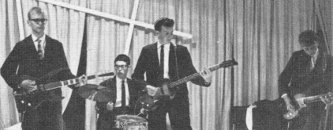
1963 - The band renamed itself to guitar combo The Golden Earrings named after a song by Peggy Lee. The first change in the band line up was a fact: by late 1963 Hans van Herwerden had to leave the band because his parents did not appreciate his musical ambitions. Peter de Ronde replaced Hans van Herwerden (guitar). The first beat sounds which were imported from England affected The Golden Earrings as well: no more instrumental pieces, start singing! So recruting a singer had priority. The band continued to play school parties.
Rinus Gerritsen was still at school in 1963/1964 season. He attended the Anne Frank Mulo at the Weesperstraat, Den Haag. From this school Corry Wiegmann sent a picture which shows the group in front of a touring car at a school trip. On this trip both Rinus and Milly Gerritsen can be seen. Two classes (grade 2 and 3) went on the trip. Rinus Gerritsen was in the third grade, Milly in the second grade.
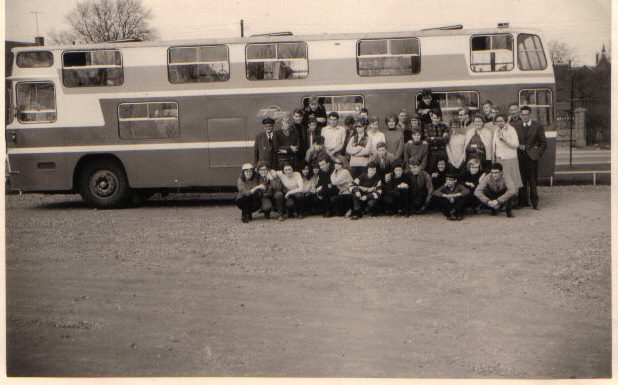
1964 - Singer Frans Krassenburg joined the band. At the end of 1964 drummer Freddie van der Hilst left. The band also wanted the much more talented drummer Jaap Eggermont to join them. He left his former group The Pirates. During one of the gigs from The Pirates at the local venue "De Haard" in The Hague, he was seen in action by The Golden Earrings. Soon afterwards they asked him to join their band. They also took over The Pirates manager Jaques Senf, who made their band much more professional as he for example raised their fee by asking money for the costs of transport of equipment and bandmembers. Meanwhile the boys wrote some material of their own, to be released on the lp Just Earrings with covers by The Kinks and The Zombies for example. At that time the band played a lot of covers as well like She's Not There (The Zombies), You Keep Me Hanging On (Vanilla Fudge) and What I Say. These songs were not coincidental as George was crazy about soulmusic at that time.
In 1966 greasers (Vetkuiven) were still the majority within the youth culture. Just like in Brighton (England) several different groups of youngsters met and exchanged unfriendly physical contact on the beach of Scheveningen. Scheveningen borders The Hague and has been a North-Sea tourist resort for decades. In 1965 ‘Club 192’ opened it's doors at the Pier (peer) on the beach of this town.
In 1965 you could go and see a beatband performing live every day of the week. There were literally hundreds of bands rehearsing and playing in town. The Hague had become the Liverpool of Holland. The main contributor to this development was the emergence of the so called Indo-rock movement of the late Fifties and early Sixties, which until Beatlemania, had rocked The Hague. When the rest of Holland was still listening to Frank Sinatra and Dutch singers doing covers of Frank Sinatra, youth who immigrated from the former Dutch colony Indonesia, had already been copying Rock & Roll music.
Mixed with the instrumental sounds of groups like The Shadows, and folkmusic from Indonesia they created a unique sound. When in 1964 The Liverpool sound reached The Netherlands only The Hague had musicians with electrical equipment and stage experience in between there borders, so many bands started out with members from former indo-rock groups.
The Golden Earrings however started their career in the legendary Houtrust complex, generally considered to be one of the birthplaces of beat in The Hague. It became a meeting place for the hardcore beatfans. They organized themselves in groups with names like Les Baroks and had there own way of clothing. There wore Parka’s and Desert boots, just like the Mods in England. But instead of a love for Italian scooters, there favourite way of transport was the Puch or Tomos motorcycle, with extremely high steering wheel.
Somewhere in the Sixties George temporarily quited playing with the Golden Earrings as he liked his pigeon hobby more. A friend of the band called Frankie Bekker was asked to replace him but soon George was back on guitar as he found out music was much more interesting.... I guess this event was the basis for the later on recorded song: "I'm Going To Send My Pigeons To The Sky". George bought his first guitar amplifier for the sum of 160 guilders. It was bought from the proceeds of six weeks tomatoes picking at Het Westland, Rinus Gerritsen once mentioned in an magazine article (1986)
At the start of their career Rinus Gerritsen played on a self made bass guitar. His father who was an engineer made a guitar just by looking at examples and making it himself. He studied pictures and took pieces from other guitars. Rinus was very proud of this fact and his handy father. Did you know Rinus father was the inventor of the "Snelkookpan" (fast cooking pan)? Later on he even made a double neck bass for his son when Rinus original Danelectro bass was stolen during an USA tour during the Seventies. Rinus mentioned to his father what he wanted and Rinus father build it! Rinus paid tribute to his father at the Golden Earring Jubilee Exposition by displaying the guitars and a picture of his father in his workshop.
1965 - In February the Golden Earrings performed for about 400 youngsters at the Voddenbal in The Hague. The owner of Club 192, Jacques Senf, organized a lot of activities in the beatscene of The Hague and surroundings. On the 6th, 7th and 8th of May that year e.g. more than 30 popgroups were booked for a big beatmarathon with bands like Q65, The Golden Earrings and The Scarlets. Headliner were the Kinks. Senf became the first manager for the Golden Earrings.
In retrospective 1965 proved to be a turning point in the career of the young formation The Golden Earrings. The band had been discovered during a performance at the above mentioned Club 192. That evening a guy came into their dressing room who introduced himself as Freddy Haayen. He was asked to come and see the Golden Earrings play by Jaques Senf. On behalf of the Polydor record company Freddy Haayen offered them to record four of their own songs. Of course this opportunity was welcomed very much. But the innocent band members didn't know that Freddy Haayen in fact was an architecture student, only working for the Polydor company as a trainee at their storage department and that he had never seen a recording studio from the inside. But Freddy was capable of introducing The Golden Earrings to the management of the record company and managed to bluff his way through, something which he would do repeatedly in the future.
The first recording session was done in the old Phonogram Studio, a converted gym in the Honingstraat in Hilversum and took just one afternoon. Four songs were recorded in August 1965. (Please Go, Chunk Of Steel, Lonely Everyday and Not To Find). In fact George Kooymans and Rinus Gerritsen earlier on tried to record the song at the GTB-studio but they didn't had the 25 guilders needed for the recording! Please Go was chosen to be their first single, with Chunk Of Steel on the B-side. After the recording the band and especially George begged the record company Polydor to record Please Go again with Frans Krassenburg on vocals, but Fred Haayen convinced them to release this version. To their minds the rendition of the song was far from being perfect, but apparently the public thought differently. Their first hit was a fact, partially due to the support from pirate radio station Veronica. Please Go became the first of an immense series of hitsingles. Some time later, they recorded another eight tracks in the same Hilversum studio again and their first album was ready to be launched.
At that time the band started to promote itself some more by giving interviews and some photo's appeared in magazines and papers. One of these photo sessions was done near the The Hague Gemeentemuseum. You see the boys dressed up in costumes and wearing ties. Their hairstyle is copied from the Liverpool scene and Beatles like. Only the leadsinger Frans Krassenburg got his hair cut short due to his military service call. The young musicians got themself their first manager called Jaap (or Jacques as he named himself) Senf. Bandmembers at this time are: George Kooymans, Rinus Gerritsen, Frans Krassenburg, Peter de Ronde and Jaap Eggermont.
The band had a strong wish to make it in the music scene and wanted to have professional equipment. Therefor George Kooymans had to pick tomatoes for six weeks at the Westland glass warehouses for his 160 guilders costing first amplifier somewhere during the first half of the Sixties. Nowadays that will be around 1500 euro's! Rinus Gerritsen build his own first guitar together with his father.
So in 1965 their debut album was released: Just Ear-rings, a charming beat record which was recorded in a few days at the GTB studio again. You can easily hear how close the band sounds like their examples. The Golden Earrings played the rhythm & blues-classic Sticks and stones note by note the way The Zombies did several months before with their cover, including the excited cries. One of their own songs, Please Go, was released as their first single on September 12, 1965 (Polydor S 1181). From the Please Go single over 25.000 copies were sold and the single went up to the 10th place in the national charts, which proved Freddy Haayens vision towards his superiors. On the b-side was the non-album track Chunk Of Steel which can be found on cd-samplers like "Singles 1965-1967 (BR-Music label), 3 Originals" and Dutch Treat.
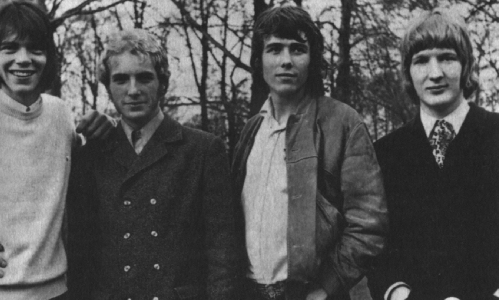
Mixed with the instrumental sounds of groups like The Shadows and folkmusic from Indonesia the Indo-rockers created a unique sound. When in 1964 The Liverpool sound reached The Netherlands only The Hague had musicians with electrical equipment and stage experience in between their borders, so many bands started out with members from former indo-rock groups. This wasn't the case with the Golden Earrings who started their career in the legendary Houtrust complex, generally considered to be one of the birthplaces of beat in The Hague. It became a meetingplace for the hardcore beat-fans. They organized themselves in groups with names like Les Baroques and had their own way of clothing. They wore Parka’s and Desert boots, just like the Mods in England. But instead of a love for Italian scooters, their favourite way of transport was the Puch or Tomos motorcycle, with an extremely high steering wheel.
The Golden Ear-rings were introduced to the press during a press conferation held in de Marathon in Den Haag on September 06, 1965.
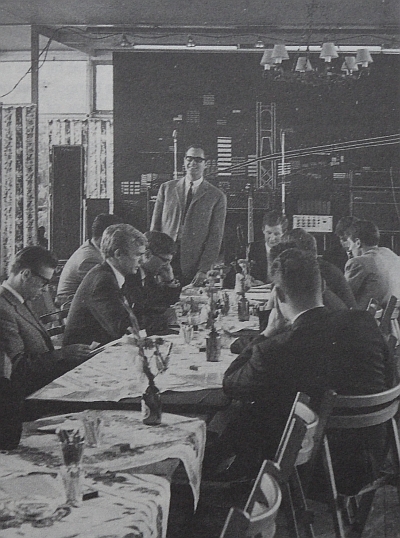
The Golden Earrings performed at the local Houtrust location for the Teenertop show on September 12, 1965 and managed to sell 2000 copies of their just released single Please Go during this concert. Please Go entered the Veronica Top 40 on September 25 at position 25, highest position was 10 and it stayed in the charts for 20 weeks! Their breakthrough had been a fact now. The band made its tv-debute on October 25th, 1965 in the teenager program Waauw, presented by Theo Stokkink.
On September 21, 1965 the band lend part of it's equipment to The Who (At least some of Golden Earrings Vox loudspeakers) That was a bit risky as The Who's reputation of demolishing parts of their equipment on stage was wellknown and questionable at the same time. However the Who did the concert but wrecked only some of their own equipment as part of their stage show.
Their debute album Just Earrings was recorded in November 1965 in just one day due to the enormous succes of their debute single Please Go.

Both their first album Just Ear-rings and single Please Go became instant hits in the Netherlands and Belgium. This album costed 10 guilders (about 4,5 euro\5 dollars!) at the time as all things were much cheaper than they are nowadays... With the growing success of his discovery, the star of Fred Haayen was also rising. He became a managing director of Polydor and later on made his career in the music industry at Polydor USA and Warner USA. Haayen was Golden Earring's producer untill the end of the Seventies and business advisor/manager untill 1982. Jacques Senf (of the Beatclub 192) was Golden Earrings' first real manager. Senf also published the first Golden Earring fan magazines called Blitz (3 different ones known, published in 1966).
On November 20, 1965 the Kinks were scheduled to perform a 3:00 p.m. concert at the Houtrusthal, The Hague (with the Golden Earrings on the bill as their support act), but Schiphol Airport was closed due to frost\fog and so they had to take a ferry. The Kinks arrived too late to appear at the concert (The Golden Earrings were the top of the bill and performed after the scheduled , Trio Hellenique, Margie Ball and the Gamblers. 3.15 p.m show starting time. Presentation Jan van Veen, promotor Jacques Senf). On November 21, 1965 the Kinks played at the VEB-garage in Beverwijk. It was a 2:30 p.m. show and the Golden Earrings were also on the bill (along with the Bintangs, the Sandy Coast and Margie Ball & the Gamblers).

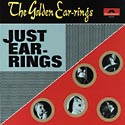
The release of another single called Lonely Everyday (Polydor S 1185) was withdrawn at the last moment as the band suddenly became aware of the fact the b-side, non-album track Not To Find, had a large grammatical error in it's title. But already 500 copies were pressed of the single and had to be destroyed. Some of these singles (less than 50!) escaped their fate at the melting oven and became collectors items for Golden Earring fans. The cover looked identical to the Please Go single but with a green instead of a blue cover colour. Not To Find can be found on the obscure lp-sampler Pebbles Vol.25 and (unofficial) cdsampler Dutch Treat, but both of these releases are hard to find.
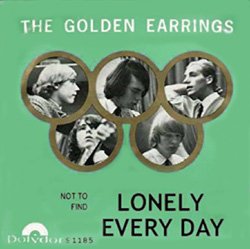
Golden Earring releases in 1965:
Single Please Go/Chunk Of Steel released in The Netherlands (7")
Single Lonely Everyday/Not To Find deleted directly after release in The Netherlands (7")
Album Just Ear-rings released in The Netherlands (LP)
1966 - Due to the success of Please Go they were given the opportunity to record their follow-up hit-single That Day on 4 tracks at the London PYE studio One with sound engineer Frank Owen. A second track The Words I Need was recorded in the same session and became the singles b-side. Both are non-album tracks and can be found on the cdsampler Singles 1965-1967 (BR-Music label) which I recommend for fans who like to have all the early single tracks in their collection. For the recordings of That Day in England the band left by train from Den Haag Hollands Spoor train station to Hoek van Holland and from there by boat to England on the night of 4 to 5 January 1966. As the were too late to book cabins the gear was stacked up at the middle deck of the boat. The boys got pretty seasick but this soon was over after their arrival on English ground. On arrival in London the band took two taxi's to the PYE studios. They were joined by The Pirates guitarist Aat den Dulk who played the piano part on That Day. The band slept at the London Cumberland hotel, behind Mable Arch, just around the corner of the PYE studios. The two songs were recorded within ten hours. According to info in the book "Golden Earring" the band did an evening gig at a London Beat-club in South London suburb Forrest Hill after recording the tracks in the PYE Studios. The band returned to Holland by boat again. That Day was also released in Germany with a different cover (Polydor International 421 023) and is the first foreign single release by the band.
So 1966 started with the huge hitsingle That Day, the first Dutch pop single ever recorded in England. The single was released on January 22, 1966 and entered the Dutch national Top 40 hitlist at position 16 on January 29, 1966. It went up to the second place of the charts and sold about 35.000 copies within 4 weeks and sales still were going on. The break-through of The Golden Earrings was a fact. The band became a shining example for the exploding The Hague beatscene, which delivered groups like Q 65, Shocking Blue, The Motions and hundreds of less known groups. The Hague became for several years the "Liverpool" near the North Sea.
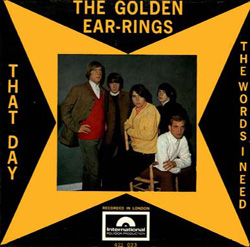
On May 07 1966 when the band was still named The Golden Earrings performed amongst many others (like The Kinks and The Motions) at a festival to celebrate to 20 year excistance of a dutch political party: PVDA. Here is an ad for this festival.
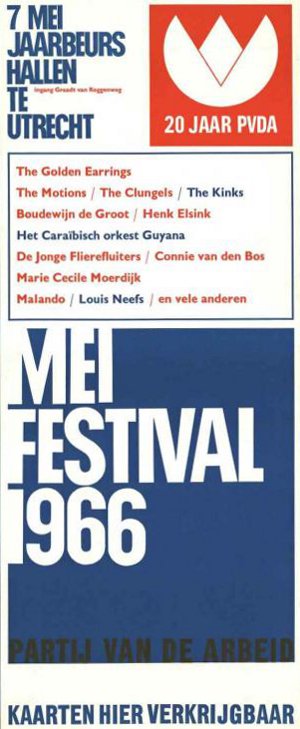
The Golden Earrings received on March 21, 1966 a "Gouden Gerbera" award out of the hands of Joost den Draayer (aka Willem van Kooten) He was the chief editor of the Teenbeat magazine which gave the award for the fact the second single of the band sold over 50.000 copies and reached up to the second place of the hitparades. After a short speech Freddy Haayen gave on behalf of the Polydor record company a complete "Cordo-Vox" installation to the band.
"The Pam-Pam" in Scheveningen and "The Marathon" would all become famous beatclubs, but besides these, Club 192 and De Drie Stoepen were the places to be. The owner of De Drie Stoepen, Adje Lagerwaard, was another notorious figure in the beatscene of the Hague. His club was an important address for new bands and established names as well as The Golden Earrings and local favourites such as The Nicols. After their tiring performances most hipsters went to the nightclub Scala. During weekdays the music shop of Servaas was the meeting place for musicians. They discussed and tried out the latest first class electrical equipment from the States. All the major bands bought their equipment over there, mostly on credit. Due to the lack of success and related financial difficulties some of them saw their instruments being confiscated even during a concert. Other wellknown clubs in Scheveningen were: Beatclub, Palais de Dance and TopTen.
In the month April 1966 the band received prices from the music magazine "Muziek Express" for the sales of over 25.000 copies of Please Go. So they received a silver record and a medaille for both Please Go and That Day.
After the huge success of That Day there was enormous pressure on the band to produce a sequel to it, so they tried to write another song in the same style called If You Leave Me. After their return from England they listened to the recording critically and decided that the sound quality was not what they wanted it to be. In the middle of the night they tried to find Freddy Haayen, but he turned out to be in a nightclub which didn't allow entry for kids of their age. After pleading for ages, the security guy at the door went to look for Freddy. He did agree with the guys about the sound quality and flew back to London the next day to remaster the record. If You Leave Me (Non-album track!) was released in May 1966 and it's highest chart position was 9 (Polydor International 421 036). The b-side WaWaiting For You is also a non-album track as well.
After the If You Leave Me experience it was clear to the band that the quality of the demo they made in The Hague was by no means less than the English one. Therefore they decided to record their new single Daddy Buy Me A Girl in Gerard Bakker's GTB Studio in The Hague. It was released in September 1966 and went up to the 12th position in the charts. The b-side is What You Gonna Tell and again these single tracks are non album releases.
The concert on September 09, 1966 in Dordrecht (Dolhuys) was probably the last show with Peter de Ronde on guitar who left the band.
So The Golden Earrings scored several other hits with their fresh beatsongs If You Leave Me, Daddy Buy Me A Girl (which entered the hit chart at #39 on September 10, 1966, highest position 12, 10 weeks in charts) and Don't Run Too Far which was released in November 1966. For the Daddy Buy Me A Girl promotion on tv a recording from the NCRV teener TV-program Twien (December 02, 1966) made by Bob Rooyens was used. You can see the band riding on animals from the circus Heros at the The Hague Malieveld. The girl who is sitting on the first elephant was the English go-go-dancer Felicity that played a roll in most of Bob's shows in the mid-Sixties. Her position as an eye-catcher of the "Nederpop-tv" was later taken by Penny de Jager. In fact this recording can be seen as the first Golden Earring "video clip".
The "Hitweek" paper style magazine reported about the Daddy Buy Me A Girl single in 1966 that Golden Earring manager Jaap Senf had informed them the recording tape had an error and the single would be delayed due to the fact no vinyl press was available to produce the single. Soon afterwards he phoned them back an told them the supposed release date would be August 23, 1966. The same Hitweek magazine had a tourdate listed in the Beatagenda for August 28, 1966 at I.S.L in Helmond, Holland.
The single release Don't Run Too Far has b-side Wings and both are non-album tracks again (Polydor International 421 056). On November 12, 1966 Don't Run Too Far entered the Veronica Top 40 at position 29 and finally reached highest position 14, 8 weeks in chart.
Also this year The Golden Earrings released a sponsored Coca Cola promotional single called Things Go Better With Coca Cola\Rum And Coca Cola (Coca Cola Company SL 3004). The single was given away with the monthly Teenbeat magazine (October 1966). This single (100.000 copies pressed!) can easily be found on Internet auctions but finding it complete with the magazine and original sleeve is very hard. The single was packed in a foursided foldout cover and given away with the magazine. On the front of this foldout cover there is a picture of the band (with members Frans Krassenburg, Jaap Eggermont, George Kooymans, Peter De Ronde and Rinus Gerritsen) From the benefits (15.000 guilders) they bought an all new Red Ford transit van for their equipment. (Some people say it was a Volkswagen van!) They didn't enjoy it very much as this bus was driven to a tree in the province Zeeland a few weeks after it was bought. Rinus brother Rob Gerritsen let a young roadie called "Paultje" drive the bus for a short while but due to the accident it ended up as a total-loss. Rob Gerritsen (nowadays their manager) hit the front window and cut his upper lip.
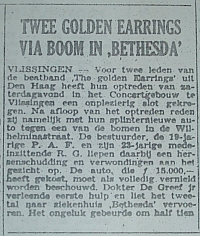
Things Go Better With Coca Cola was for the first time released on cd at the 4CD box The Devil Made Us Do It in 2000 and Rum And Coca Cola is only on the Dutch Treat sampler (which I recommend to fans as this cd contains many non-album tracks which are hard to find besides the releases on the original vinyl singles).
In 1966 the De Gruyter stores in Holland offered a special Golden Earrings beat guitar on sale for 145 guilders each.
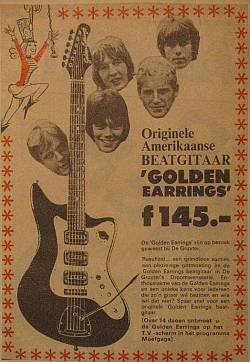
The Hitweek magazine annual 2 #10 mentioned in their November 25, 1966 issue guitarist Peter de Ronde has left The Golden Earrings. The real reason is not revealed in an interview with Jaques Senf. He only mentioned Peter de Ronde would continue to work for him in his Utrecht Club 192. After the depart of Peter de Ronde The Golden Earrings began to record their next album at the Phonogram Studio in Hilversum again. The album with title Winter Harvest was sold in record stores from January 27, 1967 on.
The Golden Earrings worked together with Cees Schrama for the first time during the winter of 1966 and early 1967 for their new album appropriately called Winter Harvest. During the Winter Harvest period Rinus got piano lessons from Cees Schrama in Cees' house (Wagenstraat, The Hague). Schrama added a lot to the sound of Winter Harvest with his piano and Hammond organ and this can be heard especially in the song In My House which was released as a single. George, Rinus and Freddy Haayen liked the organ sound "real good" and a later on this became the base for an instrumental lp to be released by Cees Schrama and the Golden Earrings called The Beast And I (May 1967). It contained the well known songs "Comin' Home Baby", "Ready Freddy" and the by Rinus Gerritsen and George Kooymans composed song "Sir Henry The Dancer".
Golden Earring releases in 1966:
To be added soon!
1967 - A few months before the release of their second album Winter Harvest guitarist Peter de Ronde left the band in November 1966. He replaced guitarist Hans van Herwerden in 1963. Peter de Ronde wasn't replaced and the Earrings went on as a quartet. They performed several shows in Stockholm (Sweden) in January 1967. On January 27, 1967 the second Golden Earrings album Winter Harvest was released. (To be sold for 11,90 guilders) on the Polydor Special label with label number 736 068. The photo's for the album were made by photographer Nico van der Stam.
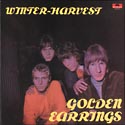
Their second album was also released in the USA on the Capitol label under the title The Golden Earrings and sold several thousand copies. The press said about it: "The sound of the early Beatles!". For the American market a totally different USA-cover was made and shows the Golden Earrings members in clothes from the early 1900 period wearing hats and near an antigue photo camera. One of the photo's showed the Golden Earring with "bolhoedjes" and this USA release is sometimes referred to as the "Bolhoedjes" cover amongst Dutch Golden Earring collectors.
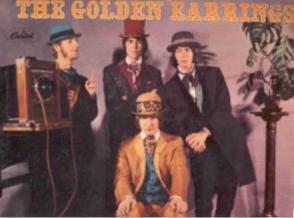
April 1967 another single called In My House was released and became a hit again: 10th position in the charts. It was a highly popular tune on the national radio stations and increased the number of Golden Earrings fans some more. Just after the release of the second album Winter Harvest (Recorded Phonogram studio's, Honingstraat, Hilversum again!) Frans Krassenburg left the band in May 1967. He had to go into the military service but he also didn't fit to the musical view George and Rinus had for their band. One year later he released his first solo single Golden Earrings, referring to his old band. Frans was replaced by Barry Hay, who left The Haigs. Barry refused an offer from the band Shocking Blue and joined The Golden Earrings. The Hague female singer Bojoura (The Bulgarian name for peony) was discovered by George Kooymans in 1967. Bojoura, in full Raina Gerardina Bojoura Cleuver van Melzen, was born in The Hague, Holland, on April 15, 1947. She is the daughter of Dany Zonewa, a well-known opera-singer and music-teacher of Bulgarian origin. This mother gave singing lessons to George Kooymans and so he got to know Bojoura. George Kooymans wrote for Bojoura the hitsingle Everybody's Day, which was released in June 1967 and became the fast start of her career. She did win several popularity polls ever since.
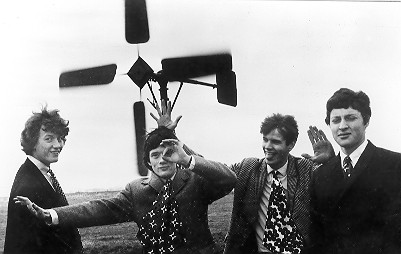
On July 07 1967 the Golden Earrings performed at the Hovor Hallen in Castricum from 21.00 hr to 21.40 hr in during the Popshow'67 event with many other bands like Whistling Jack Smith, Armand, Q65, Frogs LTD, Margie Ball, Torreros, Vin Cardinal & de Queens, Flashpoint 5. The ticket costed FL. 7,50. Ads for this show are found in Hitweek magazine annual 2#40 June 23, 1967 and anuual 2#41 1967. A review for this show is in Hitweek magazine annual 2#43 1967
Sound Of The Screaming Day was the first single with Barry Hay. Frans Krassenburg left the band after the recording of this single. Frans Krassenburg did sing the background vocals only, as the lead vocals were done by George Kooymans. At the time this single was released, Barry Hay became the new band member. He was asked during a small meeting with the band and their manager at the home of Freddy Haayen (who lived in Rijswijk at that time) and after a good night sleep Barry agreed to become the new singer. The rest is history of course... Barry Hay was already in the Sound Of The Screaming Day clip too. This film was shot July 29, 1967 and directed by Bob Rooyens again. The short movie was filmed at the "Loosdrechtse Plassen". Barry Hay became a new member of the band and this was actually the first encounter in the 'operating area' between the settled members of the band and this new band member. The slapstick type of mud fight was a perfect ice-breaker. (Years later in a 2013 newspaper article Tycho Kon (Zeist) mentioned they were on a sailing camp for a week with "De Zeeverkenners" and the shipper arranged for them to be taking part in the movie with their little steel boats (vletten) To thank them they each were given the new singel and an lp from The Golden Earrings. Barry Hay is to be heard on flute only on this single as George Kooymans did the lead vocals.
The Sound Of The Screaming Day was another huge hit for the Golden Earrings and reached to the 4th position of the Dutch charts. The new single was recorded in The Netherlands and later on edited in Kingsway studio's in Engeland: recording time 358 minutes. On July 22, 1967 the Sound Of The Screaming Day single entered the Dutch Veronica Top 40 hit chart at position 20, 13 weeks in chart (Catalogue info: Polydor S 1244) The single reached it's highest position 04 on September 02 1967. The credits for the b-side She Won’t Come To Me however are for the new singer, guitarist and fluteplayer Barry Hay. On August 05 1967 Barry did perform live for the first time with The Golden Earrings.
The single was promoted by Polydor with promo photocards which had a text on the back: Wie kent deze nog. "Belangrijk nieuws, de Golden Earrings single staat op het punt te verschijnen. Dit wordt weer een geweldige hit. Meteen bestellen bij Polydor Piet Heinplein 5, Den Haag, ...
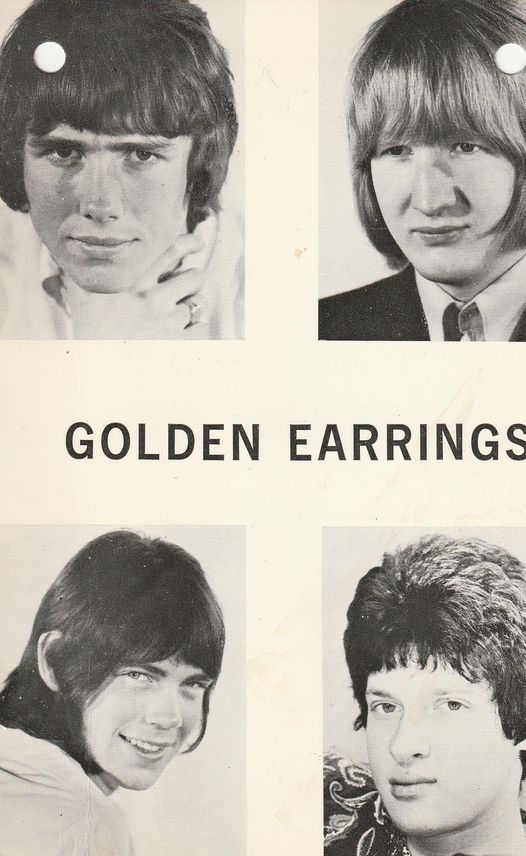
During the month August 1967 the band stayed at the residence of Circus Boltini to get some rest and wrote songs for their new upcoming album.
The summer of '67 was the summer of love, peace and understanding. Everyone was into flower power. The Beatles had a huge hit with ‘All You Need Is Love’ and the Rolling Stones did the same with "We Love You". For the Golden Earrings this was Together We Live, Together We Love, sung by both Barry Hay and George Kooymans. On this (non-album track!) single Barry Hay can be heard for the first time as singer on an A-side. It was released in October 1967 and reached up to the 6th position. As they had done before with Sound Of The Screaming Day Together We Live, Together We Love was also recorded in London, in the studio of producer Mickie Most where artists like Jimi Hendrix, Jeff Beck and The Animals were amongst the recording artists. Together We Live, Together We Love and it's b-side I Wonder - Preview Together We Live And Love (which is also a non-album track) can be found on CD samplers like "Singles 1965-1967", "Golden Earrings 3 Originals" and "Dutch Treat".
Shortly after Cees Schrama played the organ and piano on Winter Harvest Freddy Haayen suggested to Cees Schrama to record an instrumental lp with The Golden Earrings. This did result in an album called "The Beast And I" (May 1967), with wellknown songs like "Comin' Home Baby", "Ready Freddy" and the by Rinus and George composed song "Sir Henry the Dancer". (George wrote in the early start of The Golden Earrings also an instrumental song called Snamyook, which is Kooymans spelled backwards!) The album was recorded in the Phonogram Studio, Hilversum again.
On November 12, 1967 The Golden Earrings performed in the afternoon at the 5-day festival fair Hippy Happy at Ahoy Hallen Rotterdam.
The Golden Earrings by now became much more popular and amongst performing bands their could be rivalry! Willem Bieler (the now deceased) singer of Q65 gave an example in an 1999 interview: "The Golden Earrings copied mellow British bands like The Zombies, The Searchers, The Fortunes, that kind of thing. Songs like ‘That Day’ and ‘Daddy Buy Me A Girl’ I didn’t like much at all. It’s a good job that Frans Krassenburg buggered off. They became a proper rock ’n’ roll band once Barry Hay joined. Through his influences George Kooymans started to write differently". Bieler knew George Kooymans and Rinus Gerritsen for years. In the past, on the beach in Scheveningen, they jammed together on their guitars. In the local scene Q65 and the Earrings according to Bieler were, ‘friends & fiends’. "We had once a real bust-up. In ’67 we had to perform in Maastricht before the Earrings, but we arrived too late. By doing so the Earrings had to play first. They didn’t like it one little bit. They didn’t even let us use their instruments. They said, we had to build our own system. Very childish. I mentioned this once to Barry Hay who had just joined the band. We both laughed our heads off. The Earring was then already a few steps ahead of us (Q65). They were better musicians, but especially more professional. Somebody like George Kooymans made a huge difference. He was the engine of the Earring. They also had a great comradeship. We were always arguing. I know how wrong it all can go, if you’re always on the road together. It’s fantastic that the Earring after all this time has held on...."
Golden Earring releases in 1967:
To be added soon!
1968 - The big progress the band made can be heard on the album Miracle Mirror, on which the well known beat sounds were combined with psychedelic and influences from British rockmusic as made by The Kinks. For financial reasons, albums were recorded in the Netherlands and this time it was the turn of the GTB Studio again. Wind instruments and violins were recorded in Hilversum and conducted and arranged by Frans Mijts. Miracle Mirror was recorded in the GTB studio again with sound engineer Jan Audier. The mixing has been done there also.
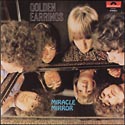
I’ve Just Lost Somebody (written by Rinus Gerritsen) was chosen to be the next single. For this single recordings from the TV-program "Moef Ga Ga" (AVRO) from April 03, 1968 were used. You can see the Golden Earrings play in a construction pit of the Amsterdam metro which was being build at that time. This was a location near the Amsterdam Scheepvaart museum.
Golden Earrings recordings were now financed by a production company called Red Bullet. Willem van Kooten (aka DJ Joost den Draaijer) and Freddy Haayen knew each other already for several years. Willem van Kooten was a well known dj for pirate station Radio Veronica and Freddy Haayen was manager for record company Polydor.

In April 1968 Haayen and Van Kooten started their own production company. The name 'Red Bullet' came from the American hitparades. The highest climber in the list got a 'red bullet' in front of it's chart position. Shortly after the start of their production company the "hitparade phenomenon" was introduced in Holland by van Kooten as well. Since then the hitparade were an institute in Holland as well and provided a lot of information for fans as well. "Dong-Dong-Di-Ki-Di-Gi-Dong was the first Golden Earrings single for Red Bullet and provided a big cashflow as it went straight up to number one!
Meanwhile the band was still searching for their own sound, as can be heard when after I've Just Lost Somebody the song festival kind-a-like song Dong-Dong-Di-Ki-Di-Gi-Dong was released on single in July 1968 (Polydor S 1277). This became their first number 1 hit song. George had actually written this song for Henk Smitskamp, the bass player who had just been thrown out of The Motions. The band members of The Motions, another popular band from The Hague, were a kind of archenemies and were rather condescending about the Earrings. George liked the idea of Smitskamp having a hit with an Earring song. However, when Freddy Haayen heard the song, he insisted that they recorded it themselves. "This is far too commercial to give away!" he said. Some time later in the first week of September 1968 the number 1 position in the charts proved him right. So Dong-Dong-Di-Ki-Di-Gi-Dong became the first number one hitsingle for the Golden Earrings. Meanwhile the teenstars had reached a superstatus in Holland.
On "Dong-Dong-Di-Ki-Di-Gi-Dong" Cees Schrama played spinet and celesta. The non-album b-side Wake Up - Breakfast!, recorded during the "Miracle Mirror" sessions, had the now well known "fading effect" again. The b-side Wake Up Breakfast is a non-album track as well and can be found on the obscure cd-sampler Dutch Treat and a few other cd compilation albums. The single was recorded in London with sound engineer Jan Audier. The single entered the Dutch Top 40 on July 27, 1968 at position #30. The accompanying video clip for Dong-Dong-Di-Ki-Di-Gi-Dong was taken from the popular pop programme Moef Ga Ga; they performed on the building site of the Amsterdam Metro (subway system) which was under construction at the time, while flash bombs and shells flew all around them. This wasn’t their first clip though; Daddy Buy Me A Girl and Sound Of The Screaming Day had also been put on film by the experimental cineast and director Bob Rooyens.
In Germany, Italy and Greece and Japan a single was released called The Truth About Arthur with b-side Gipsy Rhapsody (Germany: Polydor 59 177) from the Miracle Mirror album. The German version of this single is also known to excist as a white label promo single in a generic black sleeve (Polydor 59 177).
The band performed on November 23, 1968 at the Olympia theatre in Paris. From this visit photo's were made by Claude Vanheye and used for promotion in magazines.
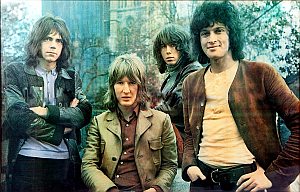
George and Rinus composed a song called "Murphy McCoy" for Livin' Blues in 1968. There still exists a demo recording on which George Kooymans can be heard singing this song. Another single (Third one) was released by Bojoura with the Golden Earrings track "Circus Will Be In Town In Time" (Written by George Kooymans and Rinus Gerritsen) and b-side Treat Me (Written by George Kooymans and Bojoura aka B. Van Melzen) The single was released on the Polydor label with label number S 1276.
German singer Hajo covered Dong-Dong-Di-Ki-Di-Gi-Dong with b-side M'Lady Molly O'Dean. This is one of the earliest Golden Earring covers. (Label: Fontana, label number: 269 412 TF)
Singer Mat Mathews could be found with a cover on the Dutch 1968 sampler album "14 Hollandse" (RCA Records).
George Kooymans produced the first single "So It Goes" of the band Gloria (Later on renamed to Unit Gloria) in 1968. The recordings took place at the Phonogram studio, Hilversum and George was present there. The single only reached the Tip parade despite much airplay at Radio Veronica. Some unique photo's of George and this recording session can be seen at the Unit gloria site. (Single info: So It Goes\So Good To Dance, Philips label JF 333 997)
Golden Earring releases in 1968:
Album Miracle Mirror (lp)
Single Dong-Dong-Di-Ki-Di-Gi-Dong/Wake Up - Breakfast! in Germany and The Netherlands (7")
Single I've Just Lost Somebody/The Truth About Arthur released in France (7")
Single The Truth About Arthur/Gipsy Rhapsody" in Germany, Greece, Italy and Japan (7")
Album Miracle Mirror released in Germany (lp)
More to be added soon!
In 1968 a Dong-Dong-Di-Ki-Di-Gi-Dong cover was released by:
1968 Germany: Hajo - Dong-Dong-Di-Ki-Di-Gi-Dong (7")
1969 - In January 1969 The Golden Earrings release, as many other popgroups during this period, a pretentious double album, called On The Double. It's a musical piece of artwork, with a lot of beautiful songs on it. For example Just A Little Bit Of Peace In My Heart - the McArthur Park by George Kooymans - which became a big hit again.

For Just A Little Bit Of Peace In My Heart George was inspired by the song MacArthur’s Park by Jim Webb which was sung by Richard Harris. In those days you also had Paul & Barry Ryan, who made that kind of film music with a lot of orchestral music. Arranger Frans Mijts was the perfect man for this kind of orchestration. First George played it to the band on acoustic guitar and then it was recorded in one take, with Cees Schrama at the piano. The tape then went to Frans Mijts, who wrote the orchestral score. This was then added in the studio to the recordings and then it became apparent that they had a kind of overkill in the wind section (Mijts was originally a trumpet player, so it figures). Half of it was edited out again and there was another song that still remains untouched by the passing of time.
With the album On The Double the band said goodbye to the Sixties. The group that produced fine pop songs did switch to a more heavy style. This was already the case during their performances, but now it could be heard on their records as well. (Starting with Eight Miles High...) On The Double is the last album which carries the name "The Golden Earrings", from the next album on the band called themself The Golden Earring. During the recordings for On The Double the song "Pipeline To Your Brain" was recorded but never released. Untill now the song is lost and never found in archives. The fact was mentioned in the 4cd The Devil Made Us Do it liner notes (2000 sampler release)
Ambitious as he was Freddy Haayen wanted to go the USA with the band. So in 1969 Golden Earring visited the United States for the first time playing both Fillmore's as openers for Delaney, Bonnie and Friends (featuring guitarist Eric Clapton!). Some of the shows for their first tour were done at New York (The Scene, May ?, 1969), New York (Fillmore East, May ?, 1969) and Detroit (Grande Ballroom, May 16, 17, 18 and 19, 1969). At first this tour was supposed to be a disaster as the tour was likely to be postponed due to missing work permits. The band was already on Schiphol Airport on April 24, 1969 but had to stay in Holland.
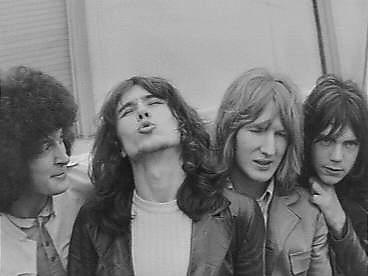
The Golden Earrings fanclub sent out a letter to all fans asking them to come to the Schiphol Airport to greet the band before their departure. At first their was a press conference at 13 hour and the planned departure was at 14.45 hr. The band heard at Schiphol airport the working permits were not available and so only manager Freddy Haayen boarded the PanAm plane to go ahead to New York to work out details and make sure the working permits became available.
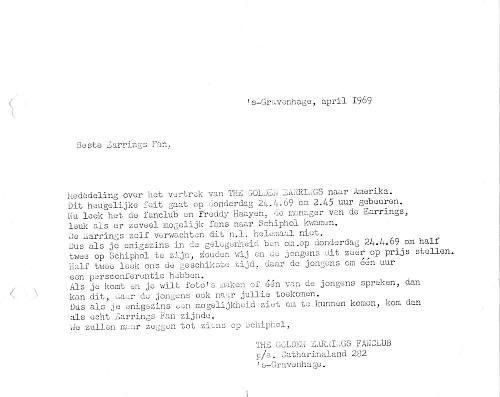

But after two weeks waiting (and hiding at the Red Bullet office in Hilversum!) in Holland the permits were there and the band left on May 02, 1969 for America. They arrived on May 03, 1969 and stayed at the Wellington hotel in Manhattan (New York). When they arrived in the USA there were no shows booked as Freddy Haayen thought he could arrange that when in New York. But there was no demand for the band. When they finally met road manager Bob Lampert with good contacts, some shows were booked. They played the wellknown club The Scene in New York and while they were there Jimi Hendrix was playing as well. But in "Ungano's" they played for an almost empty venue! But they could see Joe Cocker performing there, which was great of course.
The USA Disco Magazine of May 1969 has an ultra small article mentioning the reviewer got the Golden Earrings album in his possesion. "Two eagerly awaited albums (on my behalf anyway) just arrived on my doorstep much to my delight. They are THE GOLDEN EARRINGS (A phantastic group from Holland who sing phoenetically) and The V man Electrically Band who are very popular in their homeland Canada and hopefully will do just as well down here, if not better..."
A newspaper show ad in the Los Angeles Free Press mentioned three show at the Thee Experience on Sunset Boulevard in Los Angeles as the opener for John Lee Hooker. These shows took place on May 29, 30 and 31 1969.
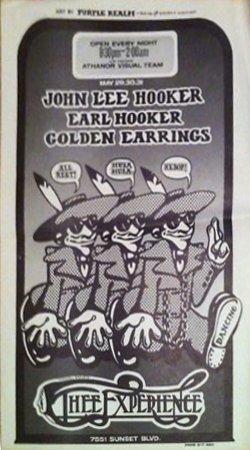
The USA Billboard Magazine of May 31, 1969 printed the article "Earrings Turn Hard - Now Easy To Hear. New York - Battling equipment difficulties, The Golden Earrings indicated they have heavy talent in the hard rock vein. The Polydor quartet opened at Ungano's on Tuesday (20) Blown fuses cut power short three times, while the organ was actually inoperable. Both sides of the single were offered, including It's Allright But I Admit It Could Be Better. As in most of the material, Rinus Gerritsen stuck to his bass guitar rather than tackle the organ, which he also plays, but the fine rock sound came through. Barry Hay provided strong vocals and also fine flute playing. On the other numbers he also handled rhythm guitar. Lead guitar was well handled by George Kooymans, who also also assisted on vocals, while Jaap Eggermont was solid on drums. The single's B-side "Song Of A Devil's Servant" was a good softer number. On this one, Gerritsen tried the electronic piano. The opening "Good Times" set the pattern for the set. The hard rock was exceptional. The organ wasn't used. A blown fuse cut the number short. Only on the closing "Eight Miles High" was the unit able to finish. although playing without keyboards. Hay and kooymans were a strong vocal duet, while Gerritsen has an excellent solo on bass guitar.This group can yet make an impact here: their new style certainly suits them. Fred Kirby."

On June 20, 1969 the Detroit Free Press mentioned "The Golden Earring will be in town soon and will be filming a TV special for Europe's Eurovision. The network is doing a thing on American youth - which make one wonder how Hollands Golden Earrings fit into the picture." Apparently the band tried to promote itself as much as possible and at that time material was shot for the Eight Miles High movie I guess. It also might have been one of the "famous bluffing tricks" from Freddy Haayen.

The USA World Countdown magazine of July 25, 1969 had another article with the following content: "There is a delightful new group on Polydor Records called The Golden Earrings. They are from Holland and have already made their first American tour. The Golden Earrings have been together for about six years and have been the top Dutch group for three. The group is very versatile and very good. The Earrings consists of George Kooymans, lead guitar and vocals, Jean Eggermont on drums, Barry Hay, lead vocals and flute, and Rinus Gerritsen playing bass guitar, piano, organ and harmonica. Quite a talented import." (Note the name Jean Eggermont. Misspelling or just made up to sound more nice for the American market, who will tell the truth...)
The first The Golden Earrings USA tour ended on June 23 1969 in New York at The Village Gate where the band performed a benefit concert for WBAI radio station.
Soon afterwards on the end of June The Golden Earrings returned at Schiphol Airport from their first USA tour. Long time serving van Cees van Rutten was present way back then. He still has a picture from him together with George Kooymans. (Cees van Rutten is the author of the book Earringgek)
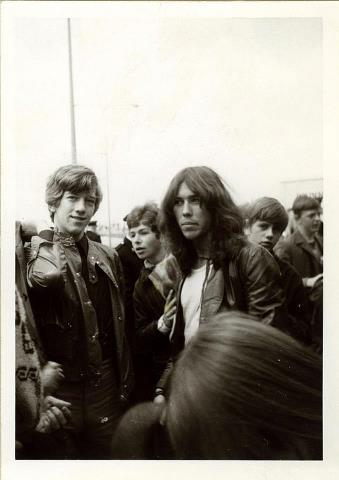


Jaap Eggermont was "the Earring drummer" from 1965 - 1969 and played a big part in the bands history a bit like Pete Best from the Beatles: the drummer who had to go before it all really happened. The difference being: Best became a frustrated moaner and Eggermont pulled through. Nowadays he arranges music for the advertising industries after his succeses with the "Stars on 45" projects. He however encountered one of the most important turning points in the history of the Earring: the joining of Barry Hay in the Autumn of ’67. Two years later Eggermont was asked to leave. Jaap Eggermont: "George had an unbridled ambition. He was consciously looking for a type like Barry Hay and wanted to be just as good as The Who. Fame in Holland wasn’t enough, their stage act had to be better. In the end I couldn’t handle the pressure any longer, just like Frans Krassenburg and Peter de Ronde. Lets say we weren’t like Johan Cruyff. I did experience the first American tour. We were of course novices over there plus there was no funny business going on. Only the groupies, they follow you around much more. If Led Zeppelin ran off quickly enough and we stayed behind well that’s when it happened."
After this first American visit drummer Jaap Eggermont left the band and became a well known record producer. Dagblad De Tijd dated July 25 1969 mentioned he left the band and would join the Red Bullet Productions team. He was replaced by Sieb Warner from The Motions. They also dropped the "s" in their name "The Golden Earrings"; it sounded better and showed more unity. Sieb's name last name was Warntjes and was changed to Warner to make it sound better for the American market. Siebold Warntjes was born on September 17, 1946.
Not too long after the band's return from America, the management of The Golden Earrings received a phone call from Jimi Hendrix. He was very impressed by the bass work of Rinus Gerritsen and asked him to join the Jimi Hendrix Experience. While very flattered by this offer, Rinus found it difficult to leave the band he knew and loved so well, and declined. There seemed to be a camaraderie or feeling of family among the members of The Golden Earring. In fact, Rinus's brother Robbie had been the band's booking agent and road manager from the very start, and in October of 1969, George Kooymans married Rinus Gerritsen's sister, Melanie.
But more things changed. To understand them Rinus Gerritsen did explain the situation (See liner notes 4cd release The Devil Made Us Do It, published October 2000). Until the mid-Sixties, the record business had always been the domain of executives and producers. Artists usually only had a very limited influence on the whole process, just did some playing and singing at the end of the whole process and got paid for their services with (usually low) royalties. Only logical when you consider that all the costs of the production and promotion were paid by the record company, which was therefore taking the financial riscs. The songs were provided by music publishers, which were often connected with the music publishing company itself. After the Beatles appeared, and many other bands in their wake, things changed. A group would write, play and direct the recording of it's own songs and therefore it would determine the costs as well. This often got out of hand, as musicians are usually not businessmen and tend to place their ideals above budgets. Contracts were soon adapted and made sure the artist would have to finance part or all of the costs, for which they would receive slightly higher royalties in return. By definition, a band doesn’t have much financial strength. For example a band needs to equip itself (PA, instruments and other musical equipment) and has personel costs for roadies and everything that goes with performing live on stage. So the record company or the production company would usually lend the band the money and then you have a situation that has proved fatal for many bands. Because if success doesn’t occur, all that’s left then for the band is debts, the eventual break-up and finally getting lost in the twilight zone.
Haayen, who had not been idle in the meantime, had started a production company with Willem van Kooten, the Netherlands’ most famous radio DJ, wellknown from pirate radio station Veronica. Their production company is called Red Bullet. From that moment on all the Golden Earring related matters were taken care of from Hilversum, Holland by Red Bullet booking agency: management, booking shows and recording records. That way all the finances came from one source.
While visiting the USA and no shows to perform they took the opportunity to get into the studio during a stay in New York to record another single called Where Will I Be. The producer was called Arthur Gorson. It was recorded at legendary engineer/producer Brooks Arthur's Century Sound Recording Studios in Manhattan, New York City. He had them play a song many times and recorded as many takes as well. The band did what was asked for until they couldn't go on. The guys thought this was an usual way of working in the United States. How where they supposed to know? So in the end there was a pile of recorded tapes as high as the ceiling and the producer decided to use take 2 out of 50 recorded takes. The tape was sent home and while the band was still on tour in the States (for instance as the support act for Led Zeppelin) Where Will I Be was released June 1969 and this non-album track became a hit in their homeland the Netherlands. (Highest chart position was 7) The b-side to this single It's Alright, But I Admit It Could Be Better is also a non-album track and was released in the USA and Canada on single with b-side Song Of A Devil's Servant!
On their return from the States, drummer Jaap Eggermont left the band and began a successful career as a producer. (In the Eighties he was the producer behind the succesfull "Stars On 45 cover projects" for example!) He was replaced by Sieb Warner (Or Warntjes as he last name actually is!) Sieb was asked by George Kooymans. Sieb had seen them play in Club 192 and thought they played well. When he was asked by George Kooymans Sieb Warner joined the band. At that time Cesar Zuiderwijk also rehearsed at the Club 192, but was still in another band...
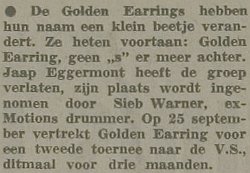
After their first USA tour the band started to move the equipment and the band itself in a Mercedes van (With license plate number ZN-17-78). It's a white van, with the band name Golden Earrings written in red on the left back door.
In August of 1969, the band went to the Olympic Studios in London to record another new album with their new drummer Sieb Warner: Eight Miles High. On several occasions, the Rolling Stones were present at the studio's during these recording sessions. The release of the Eight Miles High album was on October 26, 1969. It featured four original songs on the A side and the entire B side was comprised of a 19 minute powerhouse version of The Byrds' classic. With the inclusion of the Coca Cola promotional single, Eight Miles High was the fourth song The Golden Earring(s) had recorded and released which was not an original composition. (Sticks And Stones was the first one)
When the Eight Miles High project was first conceived, a decision was made to capture the event on film, including footage of 1969 tour performances, interviews, clips from the recording sessions and even nude belly-dancers. The Eight Miles High movie was made exclusively for Dutch television and was broadcasted by the VARA on November 14, 1969. In this movie by director Mat van Hensbergen there were recordings of a song called 'I'm In Good Shape, Baby'. This song was never released. There are also views from the track "Its Allright But I Admit It Could Be Better". This song was performed live at BBC TV 1969 to promote the single with the same name which was released in the USA and England only. But you also see the band playing Tell Me Baby You're Never Gonna Leave Me (live performance, later recorded by Patricia Paay with Golden Earring) and 'Fat Jack' (played acoustic while sitting in the grass) later on recorded by Hearts of Soul. The recordings for this movie took place in July and August 1969 and the costs were about 50.000 Guilders, half of these costs were paid by the Dutch broadcasting organisation VARA. The movie was released on VHS many years later as a special fanclub release and is expected to be released on dvd although rumours about this are several years old now....
Although the film was not produced for promotional purposes, it appeared to boost record sales as the album went gold in Germany and Holland without the aid of any supporting singles. The Eight Miles High lp and an edited single version of the title track were released on the Atlantic label in the USA as well, but Rolling Stone Magazine was quick to condemn the album and sales were sparse. In England the album was released on the Major Minor label.
The in 1969 released Eight Miles High b/w One Huge Road single (Atlantic label, labelnumber 45-2710) also excists in a white label promo 45 version, both sides featuring edited versions of the forementioned tracks from the great Eight Miles High album. The USA Eight Miles High lp (Atlantic SD 8244) is a white label promo with a different cover backside compared to the Dutch one. At this time the band has their own personal USA management called New Dawn Artists Management, Inc.
Shortly after this single they also recorded the LP Eight Miles High at the Olympic Studios in London, a job they did in only five days and most of the songs were recorded "live" in the studio. At that time, when performing live on stage, they played a 45-minute version of the album title track, complete with drums and bass solos. It was now clear to the band in which direction they wanted to go regarding their style of music. Eight Miles High was also released in the States on the Atlantic label and in the Winter of ’69-’70, a second tour followed to promote the album.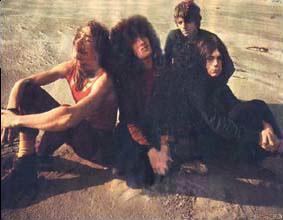
Untill this time Golden Earring performed several sets every gig, lasting the whole evening, but from September 19, 1969 on they started their concerts with a support act. Their first support act was the band Earth and fire. They were introduced to the Golden Earring by Joop Roelofs (Q'65). Members of the Earring asked Earth and Fire to go on tour with them as the supporting-act, starting September 19, 1969. Jerney Kaagman went along and was working her way in. On October 11, 1969 the band played in Irnsum (Friesland) where Jerney was "forced" on stage to join the band as their lead-vocalist. During Golden Earring's last show before the would go on tour to the USA Freddy Haayen asked Earth and fire if they wanted to record the by George Kooymans written song Seasons. The song is rehearsed at the old Marathon venue The Hague. George helped the band on November 10 and 12, 1969 with the recording of their first single at the G.T.B studio (The Hague) as the band didn't had any studio experience of themselves. Singer Jerney Kaagman reveiled in an interview many years later George Kooymans also played some guitar on the track. Seasons became a number 2 hit in January 1970 due to a lot of "airplay" on the offshore station, Radio Veronica. (Seasons\Hazy Paradise: Polydor S 1335)
George Kooymans and Rinus Gerritsen received on November 10, 1969 a Zilveren Harp and can be seen on the photo below with Lenny Kuhr, another winner.
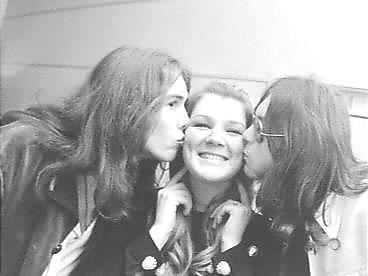
For the recording of Another 45 Miles the band visited the Olympic Studios in London, one of the most popular locations at the time. This hitsingle was inspired by the first American adventures from the band and was released in December 1969. The song was just one of a string of tunes the band would write concerning life on the road and reached a number 3 position in the Netherlands. Dutch fans were very impressed with the fact that their heroes had toured America; they were a true phenomenon. Since the single Another 45 Miles in December 1969 the band shortened their name again into "The Golden Earring". Another 45 Miles b/w I Can’t Get A Hold On Her was also released in England on the Major Minor label (Also promo stamped versions excist!) (1970 or 1969?) UK release Major Minor label, label number MM 679)
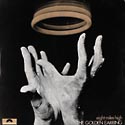
From the album with the same name the single Eight Miles High (single version) was released with b-side One Huge Road in England (On the Major Minor label, MM 2710) and in the USA on the Atlantic label (Atlantic 45-2710). Of course this single was an edit-version of the lp track on Eight Miles High album. This version is not available on any album to my knowledge.
On December 17, 1969 the band left Holland again with it's new drummer Sieb Warner and undertook it's second American tour, where they received very enthousiastic reactions for their lp Eight Miles High and especially for the title song which lasted one whole lp-side (A cover from a song by The Byrds). One of those shows the band played on December 23, 1969 at the Fillmore East on the Tuesday Night Program. On Tuesday nights the Fillmore East had new groups and jam nights. The admission fee was only US$1.50. You got to see three new bands, a new light show group and a special guest star performing. Some famous rock groups got their start there. Besides The Golden Earring T.C.B. and Bamboo were the other bands that night. But this tour also included four nights at the Fillmore West. For this tour Golden Earrings own Mercedes van was shipped to the United States. This econd USA tour was continued into 1970.
In the mid-1960s, The Fillmore became the focal point for psychedelic music and counterculture in general, with acts such as The Grateful Dead, Quicksilver Messenger Service, Jefferson Airplane, The Doors and Janis Joplin getting their start. Golden Earring had their breakthrough here in 1969 with their +40 minutes version of "Eight Miles High", still to be admired in a rockumentary-movie with the same name, shot during their Fillmore concerts. Besides rock, Graham also featured non-rock acts such as Rahsaan Roland Kirk and Otis Redding as well as poetry readings.
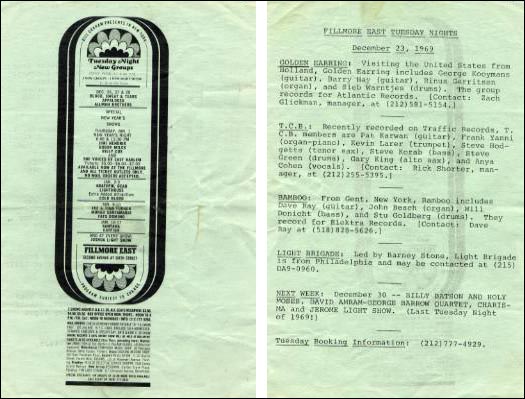
The December 06, 1969 USA Record World Magazine had an ultra small Eight Miles High review: "Eight Miles High - The Golden Earring Atlantic SD 8244. A new four-man group who definitely know where it's at how to get there and what to do on reaching the rock locale. Their rock is of the acid variety, what would have called a year ago psychedelic. Raunchy good."
The band absorbed everything trendy and returned full of new impressions to Holland. This gave the band a lasting jump start, compared to other other Dutch beat groups which remained safely behind the Dutch dykes. The Eight Miles High album was promoted with a tv special by director Mat Hensbergen and broadcasted twice for national tv. It showed how The Golden Earring worked and spent their time off at that time! In 1969 George Kooymans (the main composer of the band at that time) was awarded with a Silver Harp for his composing skills.
Golden Earring releases in 1969:
Album Miracle Mirror released in The USA (lp)
Album On The Double released in The Netherlands (2lp)
Album Eight Miles High released in the USA and The Netherlands (lp)
Album The Golden Earring released in Canada and Germany (lp)
Album Greatest Hits released in Great Britain and The Netherlands (lp)
Album Reflections released in The Netherlands (lp)
Single Just A Little Bit Of Peace In my Heart / Remember My Friend" released in Great Britain (7")
Single Where Will I Be/It's Alright, But I Admit It Could Be Better released in The Netherlands (7")
Single It's Alright, But I Admit It Could Be Better/Song Of A Devil's Servant" released in Canada (7")
Single Just A Little Bit Of Peace In My Heart/Remember My Friend" released in France, Germany, Italy and Malaysia (7")
Single Another 45 Miles/I Can't Get A Hold On Her released in the Netherlands (7")
More to be added!
In 1969 the band "Alles" covered the Golden Earrings song Murdock 9-6182 with back side "Deus Bonus Est" on single. (Philips label, label number Philips JF 336 107) The A-side track is written by George Kooymans.
In 1969 a Dong-Dong-Di-Ki-Di-Gi-Dong cover was released by:
1969 Germany?: Los Diablos - Dong-Dong-Di-Ki-Di-Gi-Dong (7")
This is a Fan site and has no direct connection with the band Golden Earring.
It's intention is to act like a library that covers and references the history of the band for fan enjoyment.
© 2003-2023 Casper Roos\Golden Earring Research, Zoetermeer, Holland. All rights reserved.

